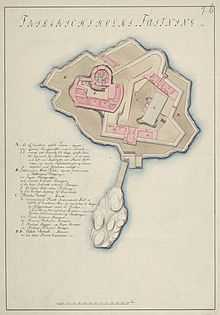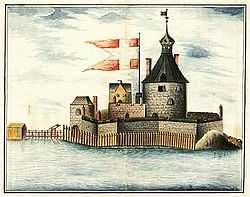Fredriksholm Fortress
| Fredriksholm festning Fredriksholm Fortress | |
|---|---|
| Kristiansand, Norway | |
|
Fredriksholm Fortress (1756) | |
| Type | Fortress |
| Site information | |
| Controlled by |
Denmark-Norway (1662-1814) Swedish-Norwegian Union (1814-1874) |
| Site history | |
| Built | 1662 |
| In use | 1662-1804, 1808-1874 |
| Battles/wars | British raid on 18. September 1807 |
Fredriksholm Fortress is situated on an islet off Kristiansand, Norway, one kilometer north of the precursor, Christiansø Fortress on Gammeløya. Both fortresses were built to protect Flekkerøy port. The construction of Frederiksholm Fortress was begun in 1655. After the fort Christiansø was abandoned on 1 May 1658, the stones, building materials and other useful material were transferred to Fredriksholm. The new fortress was completed in 1662. It is named after Frederick III of Denmark.
Complex

The fortress was divided into a lower and an upper part. The lower part was a wall that followed the shoreline. The upper part had a tower with a cupola and 2 artillery batteryes. The tower was the residence of the commander, and this was also the royal chambers. Otherwise, there were a number of large and small houses in the Fort area. Fortress walls were of stone, covered outside with turf and palisadeverk. The peat was taken from a cemetery wall in such large quantities that the coffins were almost uncovered. Within the wall there was a gallery. When the fortress was completed, consisted the luminaire of 14 cannons on the lower part and 10 guns on the upper.
The fortress was originally armed with 24 guns from 2-to 34 pounds. In 1700 the fortress was at its largest, armed with 50 cannons. Garrison was in 1658 on the 24 man. The strength of the fortress, however, varied depending on the threat of war and the season. It could be up to 110 men at the castle during the summer, while there were around 30 in winter. Fredriksholm was timed to be able to accommodate 300 men.
On the mainland in the north was in 1808-1809 built a defense battery which had the task to cover the land by Fredriksholm. The area known as Batteriodden. Batteriodden was staffed with 96 infantry and 48 artillerymen. The battery was abandoned around 1850.[1]
Destruction
In 1804 the castle was abandoned. Kristiansand had become more important and more recent and important military facilities, including Christiansholm Fortress and Lagmannsholmen, which was built over four kilometers further up the fjord to protect the city and harbor.
British attack
On 18 September 1807 the British Third-rate ship HMS Spencer along with two other ships arrived in Kristiansand. The ships returned after it being fired on by Christiansholm. The ship commander decided to adopt the abandoned fortress Fredriksholm in the fjord, and sprinkle it in the air. The blast cost four Englishmen their lives because the explosion was long in coming. Four men were therefore ordered ashore to see if the fuses had gone out. They had not[2].
The fortress was partially set in order again in 1808 and then in 1874 to be closed down for good.
Today the fortress is still in ruins. The island is an attractive place for sightseeing.[3]
Roald Amundsen's Dog Farm
When Roald Amundsen set out on the expedition to the South Pole in 1910, was Flekkerøy harbor last stop in Norway before departure. At the fortress Fredriksholm stayed nearly a hundred Greenland dogs in anticipation of getting on board the Amundsen's ship Fram. 98 dogs (two had died along the way) Fredriksholm arrived from Greenland by the steamer Hans Egede on 4 July 1910. The dogs were at Fredriksholm in a little over a month, until 9 August, when they were brought aboard the Fram. That's when 97 dogs were brought on board, one of the dogs was probably shot during an escape attempt.
Literature in Norwegian
- Helland-Hansen, Kjeld: Fredriksholm Festning, Oddernes kommune 1957.
- Fjørtoft, Jan Egil: Kanonene ved Skagerak, Agdin Forlag 1985.
- Hauschild Fredriksen, Karl: Hærens Artilleri i Kristiansandsområdet 1556-1995, 2007
References
- ↑ Fredriksholm: en festning ved Flekkerøy havn. Digitalt fortalt in Norwegian
- ↑ Fredriksholm Festning Norwegian Directorate for Cultural Heritage (Norwegian)
- ↑ Fredriksholm Fort www.visitnorway.com (English)
| ||||||||

